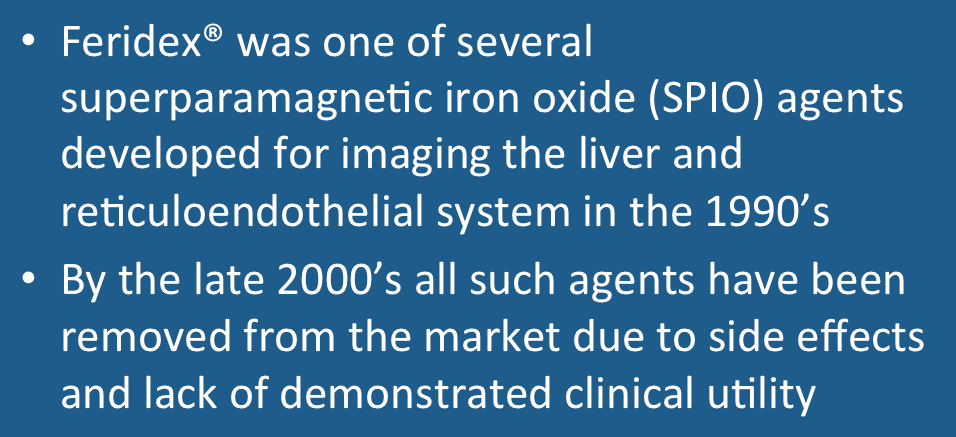 SPIO nanoparticles
SPIO nanoparticles
The largest of these nanoparticles (50-100 nm) were found to undergo rapid uptake by the liver. Smaller particles (10-50 nm), often called Ultrasmall SPIOs (US-SPIOs or USPIOs) remained in the blood for many hours and were only slowly phagocytized by the liver. These latter agents continue to excite interest as intravascular and lymphatic contrast agents, discussed further in the next two Q&As.
 T2-weighted image obtained 30 minutes after administration of Ferridex®. Normally functioning liver becomes dark while lesions like this metastasis (arrow) remain bright.
T2-weighted image obtained 30 minutes after administration of Ferridex®. Normally functioning liver becomes dark while lesions like this metastasis (arrow) remain bright.
Advanced Discussion (show/hide)»
Having lived through the first SPIO era in the 1990's, I must say that I am not particularly disappointed that Feridex® and its cousins are no longer available.
Feridex® was a disgusting thick reddish-black solution that had to be mixed into a bag of saline and administered by slow intravenous infusion over 30 minutes. From an aesthetic perspective alone, I can tell you that patients do not like watching a bag of black goo being infused in their veins! In clinical trials, a relatively high number (~0.5%) of moderate to severe anaphylactic and allergic reactions occurred. These events included dyspnea, other respiratory symptoms, angioedema, generalized urticaria, and hypotension; many required treatment.
An even larger number (10% or more) of patients experienced nonallergic but severe acute back, leg or groin pain, often severe enough to cause interruption or discontinuation of the infusion. In some patients the pain was so severe necessitating treatment with corticosteroids, intravenous narcotics, or muscle relaxants.
Daldrup-Link HE. Ten things you might not know about iron oxide nanoparticles. Radiology 2017; 284:616-629.
Hori M, Murakami T, Kim T, et al. Detection of hypervascular hepatocellular carcinoma: comparison of SPIO-enhanced MRI with dynamic helical CT. J Comput Assist Tomogr 2002; 26:701-710.
Senéterre E, Taourel P, Bouvier Y, et al. Detection of hepatic metastases: ferumoxides-enhanced MR imaging versus unenhanced MR imaging and CT during arterial portography. Radiology 1996; 200:785-92.
